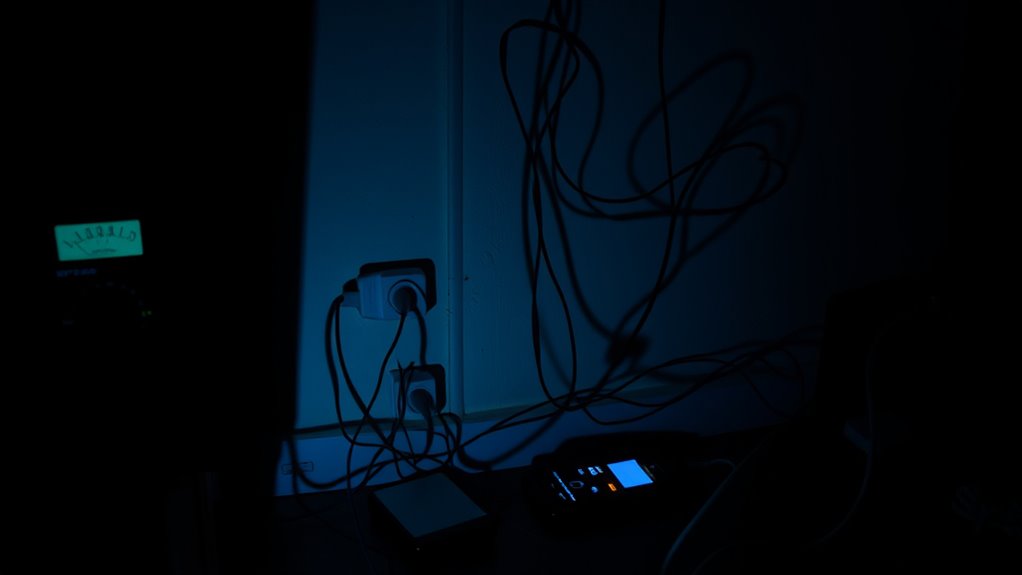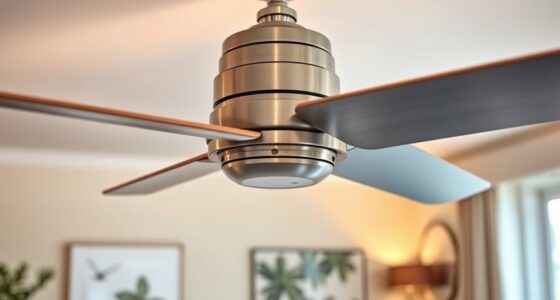Imagine waking up to find your lights flickering, yet no one else notices. That’s how phantom power quietly leaks from your audio equipment, even when you’re not using it. It’s a hidden cost that slowly adds up on your electricity bill, silently “stealing” your money at night. Understanding how phantom power works and knowing how to manage it can save you money and prevent potential harm—so, let’s explore what’s really going on behind the scenes.
Key Takeaways
- Phantom power supplies continuous current, wasting energy even when no microphones are active.
- Unused devices connected to phantom power can still draw power, increasing electricity costs overnight.
- Improper handling or leaving phantom power on can lead to electrical safety hazards and equipment damage.
- Regularly turning off phantom power when not in use reduces energy waste and saves money.
- Understanding and managing phantom power setup prevents unnecessary energy consumption and financial loss.

Have you ever wondered how microphones powered by just a single cable function without a separate power source? It’s a clever design that uses phantom power, allowing equipment like condenser microphones to operate seamlessly through the same cable that transmits audio signals. But while it may seem straightforward, understanding how phantom power works can help you avoid energy wastage and ensure electrical safety.
Phantom power supplies a small, consistent voltage—usually 48 volts—through the microphone cable to power active circuitry inside the microphone. This voltage is delivered equally through both the positive and negative audio lines, which cancel each other out in the audio signal, so you don’t hear it. This setup is efficient, but it can also lead to energy wastage if you leave your equipment powered when not in use. The power supply continues to send current even if the microphone isn’t connected or active, which means unnecessary energy consumption. Over time, this small but constant drain adds up, especially if you have multiple devices plugged in, which can result in higher electricity bills and a less environmentally friendly setup.
Phantom power provides 48V through microphone cables, risking energy waste if left on when unused.
Additionally, improper handling of phantom power can pose electrical safety risks. If your equipment isn’t designed to handle phantom power or if connections aren’t made correctly, it could cause short circuits or damage to your gear. For example, plugging in a device that isn’t meant to receive phantom power can lead to sparks, overheating, or even electrical fires in extreme cases. That’s why it’s essential to turn off phantom power when connecting or disconnecting devices that don’t require it, and always check your gear’s specifications before enabling this feature.
Another safety concern is the potential for phantom power to leak into other parts of your audio system if there’s a fault or poor wiring. This leakage can damage sensitive equipment, resulting in costly repairs or replacements. Being aware of these risks helps you take proactive steps to protect your investments. It also emphasizes the importance of regular maintenance and correct wiring practices to prevent energy wastage and ensure electrical safety. Understanding the electrical components involved can further help you troubleshoot issues and optimize your setup for safety and efficiency.
Conclusion
Think of phantom power as a sneaky leak in your home’s plumbing—dripping away your hard-earned money silently every night. By turning it off when not needed, you’re plugging that leak and saving energy. Don’t let hidden costs drain your wallet like a silent thief in the shadows. Take control of your setup, keep it safe, and guarantee your audio environment is as efficient and secure as it can be. Your wallet will thank you.
Hi, I’m Emma. I’m the Editor in Chief of Tiny House 43, a blog all about tiny houses. While tree houses are often associated with childhood, they can be the perfect adult retreat. They offer a cozy space to relax and unwind, surrounded by nature. And since they’re typically built on stilts or raised platforms, they offer stunning views that traditional homes simply can’t match. If you’re looking for a unique and romantic getaway, a tree house tiny house might just be the perfect option.










